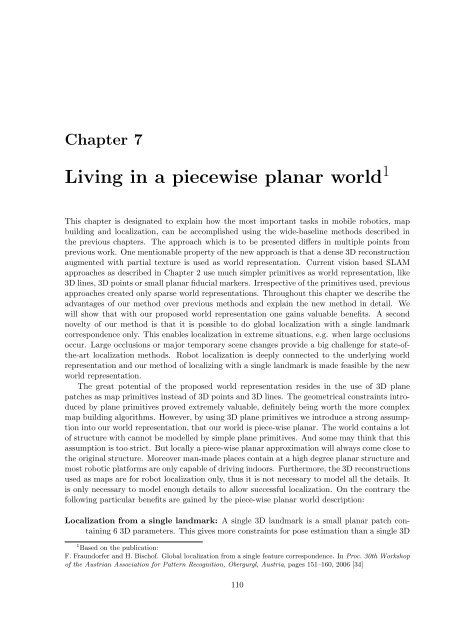PHD Thesis - Institute for Computer Graphics and Vision - Graz ...
PHD Thesis - Institute for Computer Graphics and Vision - Graz ...
PHD Thesis - Institute for Computer Graphics and Vision - Graz ...
Create successful ePaper yourself
Turn your PDF publications into a flip-book with our unique Google optimized e-Paper software.
Chapter 7<br />
Living in a piecewise planar world 1<br />
This chapter is designated to explain how the most important tasks in mobile robotics, map<br />
building <strong>and</strong> localization, can be accomplished using the wide-baseline methods described in<br />
the previous chapters. The approach which is to be presented differs in multiple points from<br />
previous work. One mentionable property of the new approach is that a dense 3D reconstruction<br />
augmented with partial texture is used as world representation. Current vision based SLAM<br />
approaches as described in Chapter 2 use much simpler primitives as world representation, like<br />
3D lines, 3D points or small planar fiducial markers. Irrespective of the primitives used, previous<br />
approaches created only sparse world representations. Throughout this chapter we describe the<br />
advantages of our method over previous methods <strong>and</strong> explain the new method in detail. We<br />
will show that with our proposed world representation one gains valuable benefits. A second<br />
novelty of our method is that it is possible to do global localization with a single l<strong>and</strong>mark<br />
correspondence only. This enables localization in extreme situations, e.g. when large occlusions<br />
occur. Large occlusions or major temporary scene changes provide a big challenge <strong>for</strong> state-ofthe-art<br />
localization methods. Robot localization is deeply connected to the underlying world<br />
representation <strong>and</strong> our method of localizing with a single l<strong>and</strong>mark is made feasible by the new<br />
world representation.<br />
The great potential of the proposed world representation resides in the use of 3D plane<br />
patches as map primitives instead of 3D points <strong>and</strong> 3D lines. The geometrical constraints introduced<br />
by plane primitives proved extremely valuable, definitely being worth the more complex<br />
map building algorithms. However, by using 3D plane primitives we introduce a strong assumption<br />
into our world representation, that our world is piece-wise planar. The world contains a lot<br />
of structure with cannot be modelled by simple plane primitives. And some may think that this<br />
assumption is too strict. But locally a piece-wise planar approximation will always come close to<br />
the original structure. Moreover man-made places contain at a high degree planar structure <strong>and</strong><br />
most robotic plat<strong>for</strong>ms are only capable of driving indoors. Furthermore, the 3D reconstructions<br />
used as maps are <strong>for</strong> robot localization only, thus it is not necessary to model all the details. It<br />
is only necessary to model enough details to allow successful localization. On the contrary the<br />
following particular benefits are gained by the piece-wise planar world description:<br />
Localization from a single l<strong>and</strong>mark: A single 3D l<strong>and</strong>mark is a small planar patch containing<br />
6 3D parameters. This gives more constraints <strong>for</strong> pose estimation than a single 3D<br />
1 Based on the publication:<br />
F. Fraundorfer <strong>and</strong> H. Bischof. Global localization from a single feature correspondence. In Proc. 30th Workshop<br />
of the Austrian Association <strong>for</strong> Pattern Recognition, Obergurgl, Austria, pages 151–160, 2006 [34]<br />
110















